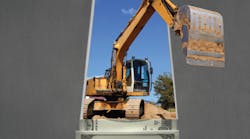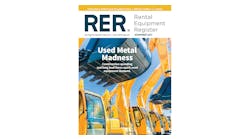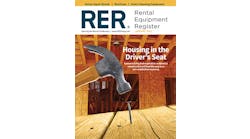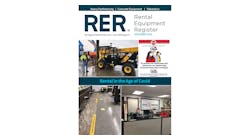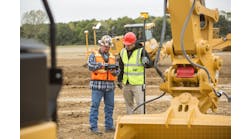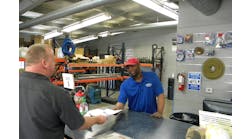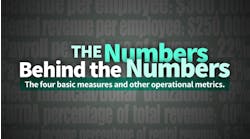At the recent ARA The Rental Show, the keynote speaker was Billy Beane, general manager of the Oakland Athletics and subject of the book and movie Moneyball: The Art of Winning an Unfair Game. Beane's presentation resonated with me, a story of David vs. Goliath; a small market, low payroll team competing against the titans in the form of the New York Yankees and other teams of superior means.
Beane says he had limited money for players and he had to make sure every dollar counted. No penny invested could be wasted on a non-performing asset (player). Beane had an unconventional idea to look beyond the standard statistics of batting average, home runs, RBIs and the like and find an overlooked key measure. Beane's key measure turned out to be on-base percentage; a statistic that reflects how often a player gets on base for any reason including walks. Beane's theory is that players getting on base equals runs, and runs equal wins.
Beane then figured out a way to recruit players with the highest on-base percentage at the lowest price. The net effect is that the Oakland A's have had the third best record in the American League since 1998 and the most efficient, lowest payroll cost per win during the same period.
What does this have to do with rental? In the rental industry, the national rental companies are the Yankees, while the independent rental companies are the Oakland A's of the industry. The independent "A's" need to get the most results out of the limited budget they have to spend on rental equipment. If they are going to compete (and yes, win!) against the "Yankees", every dollar of investment needs to make a return.
For years I have encouraged through a number of my articles (available on my firm's website, www.thestansberryfirm.com and in many cases on RER’s website, to track the basic measures of your rental business including revenues, payroll, financial (dollar) utilization, repairs and maintenance and EBITDA. Hopefully, by now, most rental companies are tracking, understand and can discuss how they are performing on these basic measures. The question becomes, is there a key "Billy Beane" measure yet to be discovered and, could it be the magic formula to winning an unfair game against the better funded national companies? While that measure might still remain to be discovered, here are some measures and advice from some who have enjoyed notable success within the industry.
Sophisticated, yet practical, advice
John McVeigh, former vice president, product management at RSC Equipment Rental, is a 30-year industry veteran with 15 years of field operation experience and 15 years of corporate-fleet management experience overseeing one of the largest rental fleets in the world. "Measure it, manage it, improve it," says McVeigh. "Most rental companies have the data available. It's important to be making informed decisions as most bad decisions are caused by not looking at the data, inaction or indecision."
McVeigh understands that independent rental companies don't have an army of analysts to pour over data but also understand that rental fleet is the single largest investment for any rental company. "If I had to recommend one key measurement for smaller rental companies to monitor, it would be the percentage of rental fleet (based on original equipment cost or OEC) that is on rent at any point in time. A solid ‘annual’ total fleet metric for fleet on rent is 72 percent (understanding monthly variances with seasonality), no more than 8 percent in a non-rental ready status, leaving 20 percent of your fleet available and ready for rent." Ironically, this fleet on-rent measure sounds a lot like Beane's on-base percentage statistic.
Non-rental-ready fleet can be a major issue for many rental companies if not monitored closely. Non-rental-ready fleet can be equipment waiting for pickup, needing a post-rental inspection, needing routine service or equipment that is "hard-down" and in need of a major repair. If you have a rental fleet with an OEC of $10 million, even at the 8 percent benchmark, that means you may have $800,000 or more in fleet that is not rentable. "That's like putting a roll of $100 bills in a coffee can and burying it in your backyard," says McVeigh. "It is a dead asset unable to make money."
As a rental store owner or manager, you are like an investment fund manager. Ultimately, it's your responsibility to maximize the performance of your rental fleet investment. This requires monitoring your software system's "down" status report, walking the yard and shop, talking with shop personnel and working with vendors to assure timely parts delivery. Your employees need to understand maintaining a rental ready status is critical to the success of the organization.
To make sure the 72 percent of the fleet you have on rent is making an appropriate return, it's important to establish some overall benchmarks and parameters. "I would always make sure to have fleet analysis tools and information at my fingertips," according to McVeigh. "It's key to set various benchmarks for returns (financial utilization) for your overall fleet, as well as individual cat/classes. What the analysis will do is narrow down your focus to a manageable number of items to address while working at maximizing performance and returns."
Another important key to action is through exception reporting that identifies the "outliers" of the fleet. These outliers may be underperforming assets not making the proper return or conversely, identifying the higher performer and trying to maximize investment in those items. Identify items that are not performing up to your benchmark and "drill down" and investigate the reasons. Do you have a maintenance issue, a rate issue or do you have too many of that particular unit?
"Fix it, rent it or sell it" was McVeigh's message. "I call addressing the non-performing assets as 'cutting the tail.' Cut the tail on under-performers and re-invest in higher performing items."
One last important opportunity to maximize returns on your rental equipment is when it is time to sell the equipment. Too often, you see rental companies regard used equipment sales as a necessary evil and not an opportunity to maximize returns. Historically, some rental companies set selling prices as a markup of net book value; others blindly take trade-in numbers from a dealer or manufacturer. "You should have a goal to get as close to a retail number, or the fair market value number as possible when disposing of equipment," says McVeigh. "You have to know the market value for the piece of equipment. Hours, condition, how the unit is equipped makes a big difference. During my time at RSC, we were first and foremost a rental company. We were not afraid to keep renting the equipment if we didn't get our number because of disciplined maintenance practices. Armed with current equipment valuations, we were able to increase nets on used equipment sales dramatically. With the size of the fleet, that equated to a very large number."
"Down and dirty" advice
"I try to keep it simple," says an independent rental store owner with an $11 million (OEC) fleet. "My key measure is that I'm looking to buy machines to bring in triple the cost of the unit in rentals over the course of the life of a machine. I find once I triple my money, it's time to sell and buy a new machine, otherwise maintenance and resale value will catch up to me. My rental software system tracks the lifetime rental amount. I may not sell it immediately after hitting the 300 percent mark, but I definitely keep watch on it. I've found this works for smaller equipment with higher returns that I may sell in the three- to four-year time frame as well as larger equipment with lower returns that I may keep for five to seven years. In recent years, with rising equipment costs, this has become more difficult, but I'm still over the 300% mark, including the amount I recover when I sell the equipment."
Using data available through Rouse Services and Rouse Analytics, I decided to test these numbers. My firm and many of our clients have found the Rouse data invaluable in setting and monitoring various benchmark data aforementioned by McVeigh. According to Rouse, annual financial (dollar) utilization for rental equipment across all categories is currently 38.2 percent and the average piece of equipment is sold after 84 months (seven years in the rental fleet). Following through with the math, seven years of 38.2-percent utilization would net a rental store 2.67 times the original cost of the machine. Adding the used equipment sale net average after seven years of 46.6 percent of OEC, the rental store would net approximately 3.14 times the original investment, very much in line with the simple rule above.
Drilling deeper on some of the most recent Rouse Data regarding financial utilization and average selling age, some of the top performing cat/classes of equipment (using the same analysis above) would be scissor lifts and skid steer loaders, both of which are returning approximately 3.75 times the original cost (including the proceeds from the sale of equipment) over the course of the investment. Top performing individual items include rammer/tampers (diesel and gas) and plate compactors, both categories returning at or above 5 times the original investment. Other top performers include 19- to 20-foot electric scissor lifts, 185 cfm air compressors and 5,000-7,000 lb. mini-excavators, all of which are at a 4X return or better.
An overall "gut check" statistic
The Stansberry Firm believes a good overall measure of rental company performance is the annual EBITDA (Earnings Before Interest, Taxes, Depreciation and Amortization) generated by a rental company as a percentage of the original cost of its rental fleet. (See Maximizing Profits from Your Rental Fleet in the April 2013 edition of RER.) This measure essentially matches cash flow with investment in revenue producing rental fleet to give a good overall indication of returns.
We have found the minimum acceptable percentage for this metric is a ratio of 20 percent EBITDA to the original cost of the rental fleet. If a company has $10 million in rental fleet (OEC), the minimum annual acceptable EBITDA would be $2 million, or 20 percent of the original cost of the rental fleet. We have seen both well run, privately held independent rental companies, as well as publically traded rental companies, achieve a ratio of 23- to 25-percent EBITDA to cash flow. A score of less than 20 percent on this measure indicates either sub-standard cash flow performance, under-performing rental assets or a combination of both.
A different perspective: A sales-oriented company
A final approach to the "most important statistic" is one that can't be ignored based on the results. For an inside look, we address a company in a growing and thriving area that competes head-to-head with a number of RER top-25 companies. Despite the intense competition, the company has nearly doubled its revenue since early 2011.
"We are a sales oriented company," states its owner. "My revenues, my EBITDA, my fleet utilization are all where they should be because of our sales approach and the rentals we generate. We don't sell price, we sell service and, as the owner, I make sure we deliver. I put our people up against any of our competitors. Our fleet is late model, as good as or better than the national companies. Our rates are competitive, we're not the cheapest and we're not the highest. We believe in customer contacts--that's my biggest and most important statistic. I want to know how many existing and potential customers my salesmen 'touch' each week. We work every job, every contractor, every aspect of the job start to finish."
In order to keep current with market activity, salesmen utilize a commercial reporting service to identify and follow emerging projects. Each of the company's salespeople is responsible for rentals on all jobs sites within their assigned territories. The progress of each job is tracked through spreadsheets with each sub-contractor identified and whether any rentals have been generated. The owner follows these spreadsheets closely and meets with each salesman individually at least weekly to discuss results. The company's philosophy is to stay with each job from before ground being broken; starting with the general contractors then working with sub-contractors such as site work/excavation contractors, utility contractors, concrete/paving contractors, framers, masonry contractors, electricians, roofers and landscapers, all the way through to completion of the job.
We find each rental company, its owners and its management has a culture and style unique to that company. The commonality we find among successful rental companies is that owners, management and employees are actively engaged and understand what the key metrics of the business are. This has become a sophisticated industry with investors willing to loan money or provide equity to those companies who have learned to "measure it, manage it and improve it." Rental penetration continues to boost the momentum of the industry. Make sure that you have your business positioned to grow or you will lose your share to better informed competitors.
Gary Stansberry is the president of The Stansberry Firm, LLC and specializes in business sales, fair market business valuations, operational consulting and positioning businesses to increase their value. More information on the company can be found at www.thestansberryfirm.com. Gary can be reached at (817) 579-7368 or by email at [email protected].
